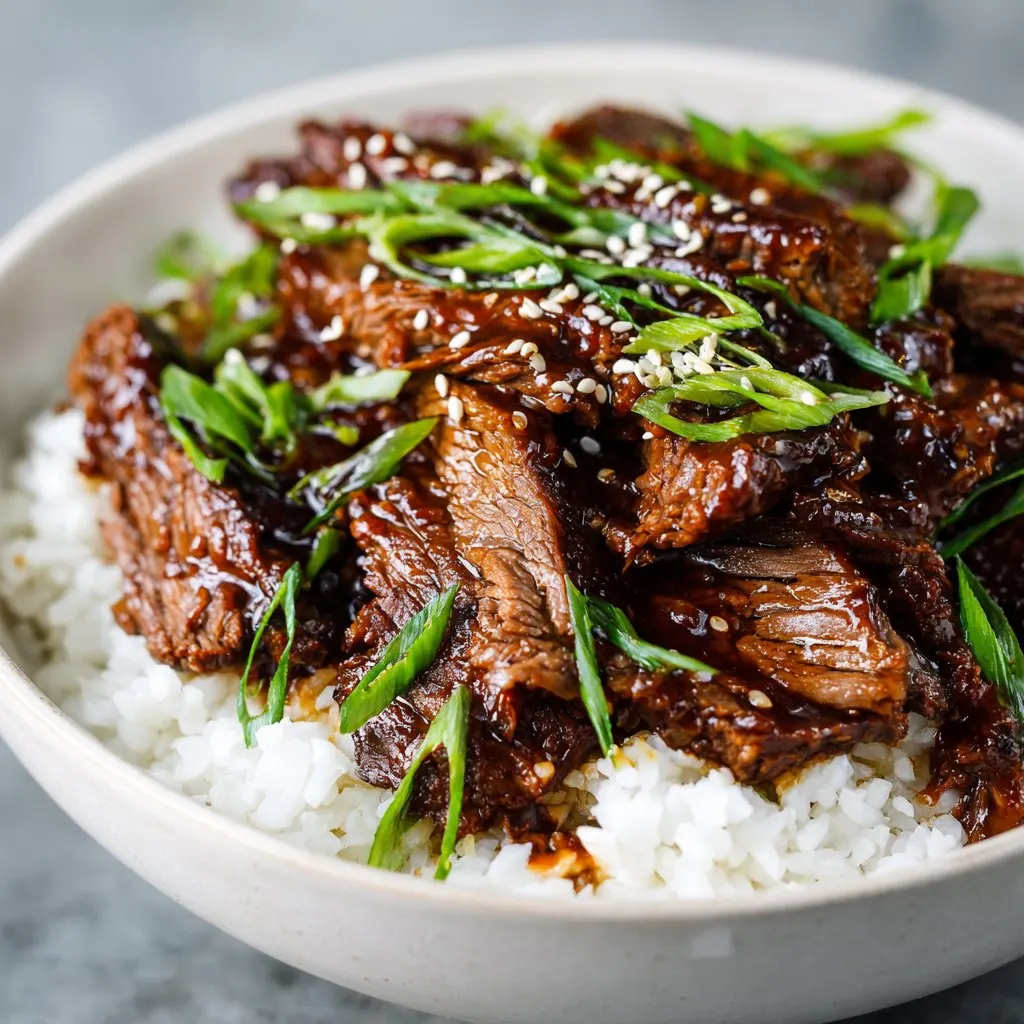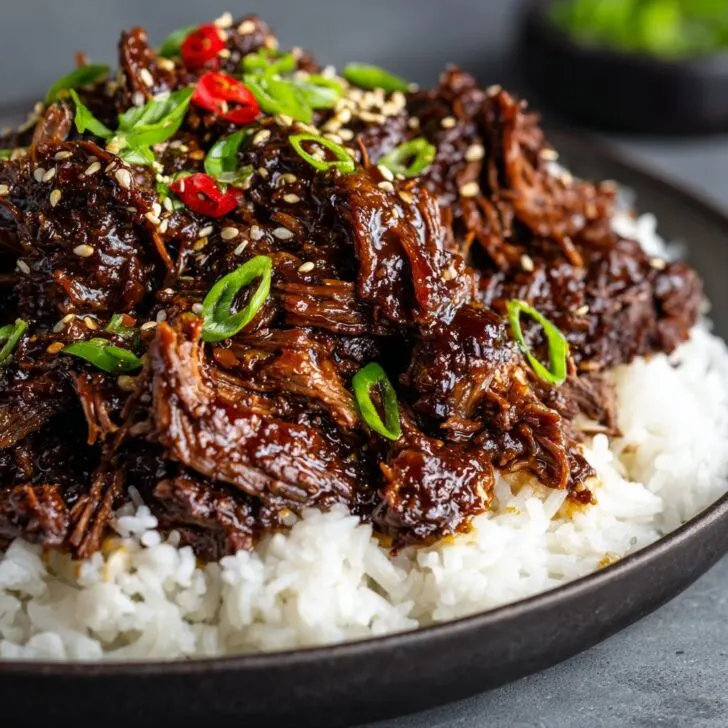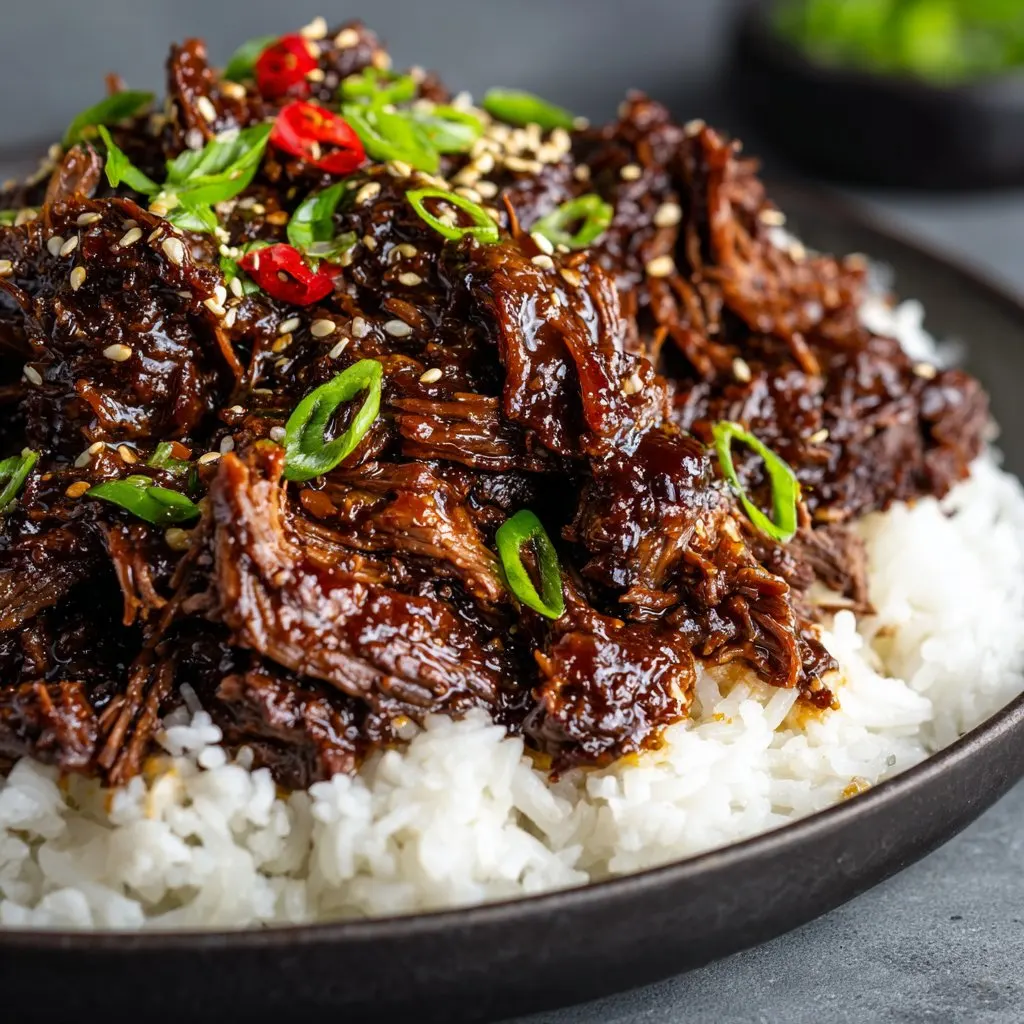Let Me Tell You About the Time I Fell for Slow Cooker Korean Beef…
You know how some days just need a dinner that basically cooks itself? That’s me, almost every Monday. I remember the first time I made this Korean Slow Cooker Beef with Sweet and Savory Glaze — I was in a mad rush, forgot half the stuff on my grocery list, and nearly mixed up the soy sauce with Worcestershire (rookie mistake, and, uh, not recommended). But somehow, I cobbled everything together, hit the slow cooker, and after a few hours the whole house smelled like the kind of cozy, slightly mysterious takeout spot you wander into on a rainy night. Even my picky cousin asked for seconds. If that’s not a win, I don’t know what is.
Why You’ll Love This (Or At Least, Why I Do)
I make this when I want dinner to feel special but also can't deal with another round of washing three pans (honestly, who has the time?). My family goes crazy for this because it’s that ultra-tender, sweet-yet-salty beef that tastes like you worked way harder than you did. Plus, the glaze gets sticky and shiny—kids get weirdly excited about glossy food, don’t they? Oh, and if you’ve ever gotten annoyed by tough beef stew meat, this one’s like a magic trick: just set it and forget it (mostly) and it turns out dreamy every time.
What You’ll Need (And What You Can Totally Swap)
- 2 pounds beef chuck roast, cut into biggish chunks (brisket works too, or I’ve used stewing beef when desperate—just trim off the gnarly bits)
- ½ cup low-sodium soy sauce (if you only have regular, just add a splash more water or, honestly, whatever’s in the bottle)
- ⅓ cup brown sugar (I once used honey; pretty good, just a touch sweeter)
- 2 tablespoons rice vinegar (apple cider vinegar works in a pinch, but avoid balsamic—it’s…odd)
- 2 tablespoons gochujang (Korean chili paste) (no gochujang? Try sriracha, but less of it, unless you’re a spice cowboy)
- 1 tablespoon grated ginger (I sometimes skip this when I’m lazy, but it does add zing)
- 4 garlic cloves, minced (or a giant squeeze from the tube—no shame here)
- 2 teaspoons sesame oil (important for that nutty vibe, but you could use olive oil if you must—just don’t tell my mother-in-law)
- ¼ cup water (sometimes I just slosh in a bit more soy sauce and call it a day)
- 1 tablespoon cornstarch + 2 tablespoons cold water (for thickening at the end, but skip it if you like a thinner sauce)
- To garnish: scallions, sesame seeds, maybe some fresh chili if you’re feeling fancy
How To Make This Magical Beef (With Room for Mess-Ups)
- Whisk up the glaze: In a bowl (I just use a big mug sometimes), stir together the soy sauce, brown sugar, vinegar, gochujang, ginger, garlic, sesame oil, and water. It won’t look super appetizing yet, but trust me, it’s the good stuff. This is where I usually sneak a little taste and somehow spill a bit on the counter.
- Meat goes in: Put all your beef chunks in the slow cooker. Pour that glaze right over. Give it a little shuffle around with a spoon or your hands if you don’t mind getting sticky.
- Cook low and slow: Cover and cook on LOW for 7–8 hours. Or if you totally forgot to start it, HIGH for about 4 hours works okay too. Don’t panic if the beef looks a bit grey early on—it always does at this point.
- Thicken it up: About 20 minutes before serving, whisk the cornstarch and cold water together in a mug (don’t just dump the powder in—learned that the hard way). Stir into the sauce in the slow cooker. Turn it up to HIGH if it’s not thickening quickly enough, but honestly, sometimes I just eat it how it is.
- Shred and serve: Take out the beef, shred it with forks, pop it back in, and let it soak up the sauce while you set the table (or scroll aimlessly, who am I to judge?).
Notes from My Kitchen Fails & Wins
- I once forgot to add the sugar. Turns out, it’s really not optional if you want that classic sweet glaze. But hey, the salty version is still edible—just not wow.
- If you’re out of fresh ginger, a pinch of ground ginger does work… though it tastes a bit different. Good in a pinch.
- This actually tastes even better the next day (if you have leftovers, which is rare around here).
- The glaze will seem thin at first. Don’t freak out; it thickens as it cools, and also when you reheat it for leftovers.
Variations I’ve Tried (And One I Regret)
- Swap in pork shoulder—works perfectly, and you get a nice twist on the flavors
- Add a handful of sliced carrots or bell peppers in the last hour for some veg (but don’t add too early or they go mushy—trust me)
- I tried adding pineapple once, thinking it would be fun—honestly, not my best move. It turned the glaze weirdly watery. Maybe it works for others, but not my thing!
Equipment (And What to Do If You Don’t Have It)
Obviously, a slow cooker is ideal (I use my old Crock-Pot, which is probably older than my kids). But if you don’t have one, you can actually do this in a Dutch oven at the lowest oven setting (around 275F/135C) for about 3–4 hours. It’s not quite as foolproof, but still turns out nice. I’ve even heard of folks using their Instant Pot slow cook setting, though honestly, I’ve never gotten the hang of that—maybe I’m missing something?

How Long Does This Last? (Not Long in My House!)
Store leftovers in an airtight container in the fridge—should be good for up to 3 days, but honestly, it’s usually gone by day two. If you actually have discipline, you can freeze it for up to 2 months. Thaw overnight in the fridge and reheat gently so it doesn’t dry out.
Here’s How I Serve It (And You Could Too)
My favorite way? Piled onto steaming jasmine rice with a mess of kimchi on the side. (Check out Maangchi’s kimchi recipe if you’re feeling adventurous.) Sometimes I do lettuce wraps, which feels lighter and is a hit at picnics. And if you’re into fusion, this stuff makes a mean taco filling—just add a splash of lime and some crunchy slaw.
Pro Tips I Learned the Hard Way
- I once tried rushing the glaze thickening step by tossing in cornstarch early—ended up with weird lumps. Always mix it with cold water first, or you’ll regret it!
- Don’t over-shred the beef; you want nice big bites, not beef confetti.
- If you forget to turn the slow cooker on (happened to me, don’t judge), you can rescue it on the stove, but you’ll lose that fall-apart texture. Still tasty, though!
FAQ (Straight From Real Friends and One Nosy Neighbor)
Can I make this gluten-free?
Yep! Just make sure to use a gluten-free soy sauce (tamari works), and double-check your gochujang. Here’s a handy guide: Celiac.com gluten-free foods list.
What if I don’t eat beef?
You can totally use pork shoulder like I mentioned above, or even chicken thighs (but cut the cooking time by half or so). Tofu… well, it goes a bit soft, but it’ll soak up the glaze if you don’t mind the texture shift.
Why isn’t my sauce thick?
Honestly, I’ve had this problem too. Sometimes it needs a bit more cornstarch, or just a little more time. If you’re getting impatient, you can pour the sauce into a saucepan and simmer it for a few minutes on the stove.
Is it really spicy?
Not too spicy—my kids eat it! But if you’re nervous, start with just 1 tablespoon gochujang, and add more next time if you want. Or pile on more fresh chilies if you want to sweat a little (in a good way).
Can I double the recipe?
Absolutely, as long as your slow cooker can handle it. If it gets too full, the beef might steam instead of braising, but it’ll still taste good. Might need a bit longer for everything to get cozy in there.
So, that’s my favorite Korean Slow Cooker Beef with Sweet and Savory Glaze. If you get inspired, tag me on Instagram (or just send a text, honestly), and let me know if you find a variation that’s even better. I’m always up for a new experiment—that’s what makes cooking fun, right?
PS: If you want to learn a bit more about Korean cooking, I adore Korean Bapsang—loads of great info and recipes I wish I’d found sooner.
Ingredients
- 2 pounds beef chuck roast, cut into large chunks
- ½ cup low-sodium soy sauce
- ⅓ cup brown sugar
- ¼ cup rice vinegar
- 2 tablespoons sesame oil
- 4 cloves garlic, minced
- 1 tablespoon fresh ginger, grated
- ½ teaspoon black pepper
- 2 tablespoons cornstarch
- 2 tablespoons water
- 2 green onions, sliced (for garnish)
- 1 tablespoon sesame seeds (for garnish)
Instructions
-
1In a medium bowl, whisk together soy sauce, brown sugar, rice vinegar, sesame oil, garlic, ginger, and black pepper.
-
2Place the beef chunks in the slow cooker and pour the sauce mixture over the beef, ensuring all pieces are coated.
-
3Cover and cook on low for 8 hours, or until the beef is tender and easily shredded.
-
4In a small bowl, mix cornstarch and water to make a slurry. Stir the slurry into the slow cooker during the last 30 minutes of cooking to thicken the glaze.
-
5Shred the beef with two forks and stir to coat with the thickened glaze. Garnish with sliced green onions and sesame seeds before serving.
Approximate Information for One Serving
Nutrition Disclaimers
Number of total servings shown is approximate. Actual number of servings will depend on your preferred portion sizes.
Nutritional values shown are general guidelines and reflect information for 1 serving using the ingredients listed, not including any optional ingredients. Actual macros may vary slightly depending on specific brands and types of ingredients used.
To determine the weight of one serving, prepare the recipe as instructed. Weigh the finished recipe, then divide the weight of the finished recipe (not including the weight of the container the food is in) by the desired number of servings. Result will be the weight of one serving.
Did you make this recipe?
Please consider Pinning it!!


